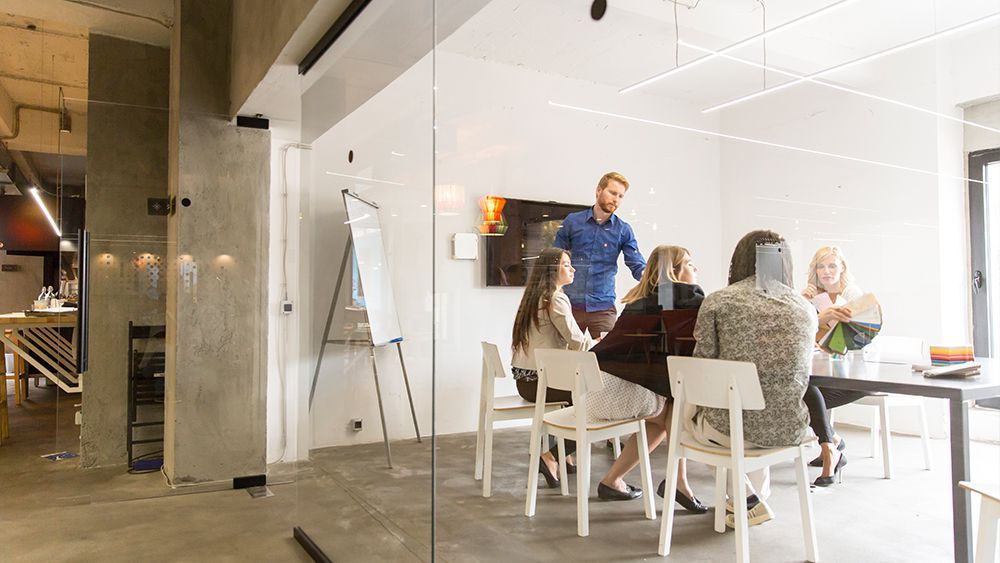
Key Takeaways
- Optimal office temperature can improve productivity levels.
- Warmer environments may reduce the ability to make critical decisions.
- Central AC suits large offices; mini-splits and window units work well for smaller spaces.
With 40 hours work weeks being the norm, most of us spend about one-third of our lives in the office! Naturally, being comfortable in your work environment is the best way to love the time you spend there. But to get cozy at work, you need to find a way to reduce work-related stressors and maintain the best office temperature.
Office air conditioning can be just the thing to ensure a comfortable workplace. The perfect office temperature can also increase efficiency and boost your productivity.
So, let’s dig into what the best office temperature is, how you can achieve it, and everything else you need to know about office air conditioning!
- Office Temperature Standards and Recommendations
- Factors That Affect Office Temperature Needs
- How Is Productivity Linked to Office Temperature?
- Ideal Office Temperature for Productivity
- Ideal Humidity for Office
- What to Do if Your Office Thermostat Is Not Set to Your Preferred Temperature?
- Automating Office Temperature
- Can Office Air Conditioners Be Harmful?
- Which Type of AC Is Best for Offices?
Office Temperature Standards and Recommendations
While it might be near impossible to set an office temperature that pleases everybody, the ASHRAE Standard 55 defines a set of conditions that would be acceptable to most occupants. This standard recommends that indoor temperature for occupied spaces such as offices should be between 67°F and 82°F.
The US Department of Labor Occupational Health and Safety Administration (OSHA) also recommends air conditioning temperature for offices between 68-76°F to maximize employee comfort and productivity.
You can also use these standards to reference what the perfect temperature and humidity settings should be when you’re working from home.
It’s important to note that these recommendations are for guidance only, and there are no hard and fast rules about what temperature offices should use. The only legal obligation that employers face is to ensure employee safety, including keeping them safe from extreme temperatures.
Factors That Affect Office Temperature Needs
Getting everyone to agree to one specific thermostat setting is an impossible feat to accomplish. There will always be that one co-worker who is either too hot or too cold!
When it comes to temperature preferences, several factors affect this choice.
1. Gender
Gender plays a significant role in temperature preferences. Commonly, women prefer higher thermostat settings than men do. The reason being that most women naturally have lower body temperatures. Due to this physiological difference, the standard office temperature recommendations do not always suit women.
2. Weight
Body size affects temperature requirements. The more fat the body has, the harder it will be for heat to dissipate through the skin. As a result, individuals with more body mass will want to keep the air conditioning at a lower temperature.
3. Age
Unlike other factors, age does not directly affect the body temperature, but it does affect your body’s ability to control temperature. An article by the US National Library of Medicine attributes this to the decrease in fat below the skin, leading to you preferring a higher AC temperature in your workplace.
4. Humidity
If you live in a humid area, you most likely already understand the struggle of moist heat. The human body cools down through sweating – the evaporation of moisture present on one’s skin. Therefore, when humidity is high, the sweat on your skin can’t evaporate as quickly, and your body remains hotter for a more extended period.
5. Clothing
Clothing affects your temperature needs and vice versa. This factor is of particular importance when taking into consideration formal attire for men and women. Office-appropriate clothing for the former tends to be layered suits made with thicker material that offer more protection to the body from the weather. On the other hand, women tend to wear thinner fabrics at the office.
6. Health Conditions
Your underlying health conditions may also affect your temperature needs. For example, many long-term diseases like high blood pressure, diabetes, and even menopause in older women alter your body’s core temperature.
How Is Productivity Linked to Office Temperature?

You’ve probably often heard that office air conditioning can impact employee productivity. But what exactly is the connection?
Temperature affects employee behavior which can then either increase or decrease productivity. For instance, office temperature:
1. Impacts Movement and Pace
Offices that are too cold risk hurting their employees’ pace and movement around the workspace. Lower temperatures cause our muscles to tense, restricting movement and breaking overall concentration. This is even worse when employees move from the intense heat outside to the extreme cold inside the office. Also, with the office too cold, employees are more likely to seek out warmer places, thus spending less time in meaningful interactions outside their own space.
2. Affects Mood
The human body reacts to changes in temperature on an emotional level. Our brain associates the environment around us with feelings. For example, the cold makes us feel more isolated, while warmer temperatures make us more friendly. However, extreme heat is also associated with higher tempers, so getting too warm might not be a good idea!
3. Impairs Decision Making
Office temperature can affect our decision-making abilities. Lower temperatures make us more alert, while warmer temperatures will make us shy away from complex decision-making. This is particularly important if you are in an administrative position to make critical decisions for yourself and your office.
4. Increases Morale
You will often find that when the temperature gets too high or too low in your office, morale in the office also changes. On the other hand, when AC temperature is ideal in your office, you and your co-workers can efficiently work together to find common ground, so productivity does not suffer.
Ideal Office Temperature for Productivity

Office air conditioning can influence much more than just employee comfort. The right temperature can play a significant role in overall productivity at the workplace. In collaboration with the Lawrence Berkeley National Laboratory, a study conducted by the Helsinki University of Technology stated that performance increases with temperature up to 69.8-71.6°F and decreases with a temperature above 73.4-74.5°F. The highest productivity levels are achievable at a temperature around 71.6°F.
Ideal Humidity for Office
Another environmental factor that can impact work performance is humidity. Just as with temperature, several research bodies have recommendations about what humidity levels are best. Again, there are no set rules in this regard, but OSHA does provide guidelines. It suggests that humidity control in your office should be between 20-60% to get the most comfortable workspace.
Comfortable indoor humidity levels for the workplace can change depending on the weather. Typically 30-50% is suitable for winters, for 40-50% is ideal during summer.
What to Do if Your Office Thermostat Is Not Set to Your Preferred Temperature?
While the office thermostat settings might not always be in your control, there are several measures you can take to ensure that you’re comfortable in your workspace.
1. Dress Accordingly
Clothes play a significant role in our body’s ability to deal with temperature. If the office temperature is too hot for you, dress in lighter, more breathable fabrics such as cotton. However, if you’re feeling too cold at work, opt for warmer clothes. If you don’t want to wear wool when it’s 90F outside, carry a sweater or shawl and wear it when you’re in your office. Fingerless gloves are also an option, although that might get you a few raised eyebrows!
2. Cool Your Body Down
You cant control the weather, but you can control how well your body adjusts to it! Water helps regulate your body’s temperature and keeps you cool (and hydrated!). Products such as cooling wristbands or mini-fans can also come in handy when trying to cool just yourself.
3. Get a Space Heater
Space heaters are a compact solution and can easily fit under your table. They’re pretty safe to run for long periods since most come with safety features. Find one with an adjustable thermostat so that you don’t end up too warm. Fair warning, though – space heaters can be costly to run!
4. Trade Seats
With all these thermostat wars waging in your office, you’re bound to find someone or the other who wishes they were in your place (pun intended). Swapping out your seat is a much simpler solution than getting up every hour to adjust the thermostat, only for someone to change it back.
Automating Office Temperature

The HVAC industry has undergone a significant revolution in recent years. One breakthrough came in the form of smart technology! Smart thermostats for central systems and smart mini-split thermostats for ductless units help automate temperature control and save energy!
Your best choice to make any mini-split, window,
or portable AC smart. Enhance your comfort and savings.

The size of the office and the type of air conditioning unit installed in the office influence the type of smart device suitable. A thermostat coupled with sensors or a zoning system is excellent for a large office with multiple floors. If you have a small office or a personal space with an individual mini-split unit, you can automate the temperature using a smart AC controller.
These devices allow you to control your office air conditioning from your smartphone and have various features that make temperature maintenance easier.
With in-built temperature and humidity sensors, they can precisely detect the atmosphere of the spot you want to cool! With geofencing, scheduling, and Comfy modes, you can always set automation for the perfect office temperature.
Can Office Air Conditioners Be Harmful?
Office air conditioning undoubtedly makes your lives much comfortable. But while it increases productivity in the office space, it is also linked with some harmful side effects, such as the Sick Building Syndrome (SBS).
At times, you may notice an increase in health and comfort-related complaints by you or your co-workers when you spend a significant amount of time enclosed in an office space. These are usually due to poor ventilation, air pollutants, and contaminants in the indoor area. In turn, you can avoid SBS by taking regular breaks, letting fresh air in the office, and even stretching in your desk space.
Which Type of AC Is Best for Offices?
Office air conditioning has evolved from traditional methods. It takes seconds to heat or cool a space, and current HVAC systems are more energy-efficient and practical than ever. With zoning, personal cooling, and smart air conditioning, you can reap benefits with the best type of air conditioning system in place for your office.
1. Central Air Conditioners
Central, also known as ducted air conditioners are an ideal solution for cooling large spaces. Ducted cooling systems consist of an indoor unit and flexible ducting to distribute cold air throughout your office via vents. The ability of these air conditioners to cool down large spaces in a small amount of time and their centralized control makes them a popular choice for office air conditioning.
2. Window Air Conditioners
Window air conditioners or window heat pumps only cool down one room at a time. You can install these in either your window or through the wall. Window ACs have several perks, such as being cheap and accessible, as well as low maintenance. The only catch is that you need a window that you wouldn’t mind obstructing.
If you can’t spare a window, through the wall ACs are the next best option, however they require a large hole in the wall which is more permanent.
3. Ductless Mini-Split Air Conditioners
Ductless mini-split air conditioners are split into two parts – an indoor and outdoor unit. Both are connected by a small hole on an exterior wall. They are widely popular as an office air conditioning solution due to their personalized temperature control for small spaces. In addition, these units are small and easy to install, making them accessible to small businesses.
4. Portable Air Conditioners
Portable air conditioners are ideal for offices that need a cheap and instant cooling solution. These AC units are easy to move around and require no installation, making them very cost-effective. However, they do have several downsides. For instance, they can be quite noisy because the compressor is inside the unit. They require a window for the hose. They also have a minimal capacity and only cool small spaces.
You now know what temperature your office should be and how you can achieve the ideal temperature for office air conditioning. Office air conditioning is a complex matter heavily reliant on factors depending on your body and your office environment.
In any case, your office AC temperature can easily be controlled and maintained to your preference. The ideal air conditioning temperature for your office should be your liking for a productive time!









1 Comment. Leave new
What a fascinating essay about the relationship between office cooling and output! The right temperature, each person’s preferred level of comfort, energy efficiency, and air quality all contribute significantly to a productive workplace.